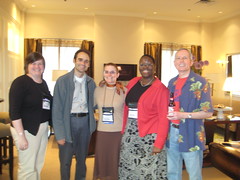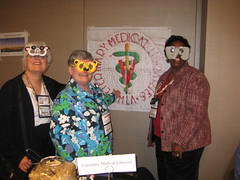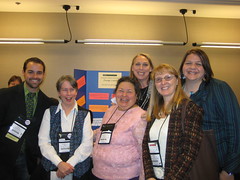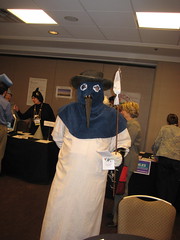MLA 2008: on “being important”
Who are these folks? They may very well be the people leading MLA into the future. For years we’ve been hearing how librarians will begin to retire en masse. Is this happening? (and indeed, as the McGovern lecture noted, are they even able to?) As this happens, how will MLA deal with changing leadership? What do our new members want, expect, need from our organization? When MLA asked whether members had joined or participated in the New Members SIG when they first started out, 32% responded “What’s that?” Clearly there is a need for more dialogue with newer members whether its their first job or third career.
So that’s where the above picture came from. A number of newer MLA members involved in leadership roles gathered at a special reception to discuss future MLA programs and services that would particularly interest them. Some of the discussion centered around how the MLA leadership structure works: what is this mysterious board? How does one get involved? What are the rules and processes that govern our association work, and how can we make them more transparent, more accessible? As Sara McCoord pointed out, “I didn’t even know there was a manual until after I wrote one.”
One idea I thought particularly interesting was introducing an MLA Board shadowing program for newer members and ’emerging leaders’. (Bart Ragon jokingly called it a “shadow government”.) These ‘interns’ wouldn’t be voting members (this is important because that requires a change in Bylaws), but this is one way to pass on that “50,000 years of collective knowledge” Mark Funk talked about in the opening session.
Around here at LSUHSC we joke about “being important”: serving on committees and sections in our region, writing grants, doing novel work at our institution and in the community that helps serve our patrons better: all this justifies us attending these meetings in the first place. As a national association, we need to think about how every single member can “be important”. There are more ways of reaching out to remote, new or disenfranchised members than ever before. (Live webcasts are a great start.) Getting new members, getting more members involved in MLA work, making the whole governance process more transparent: these are all excellent plans. The question is, now that it’s started, how are we going to continue it?

 myLSUHSC
myLSUHSC






